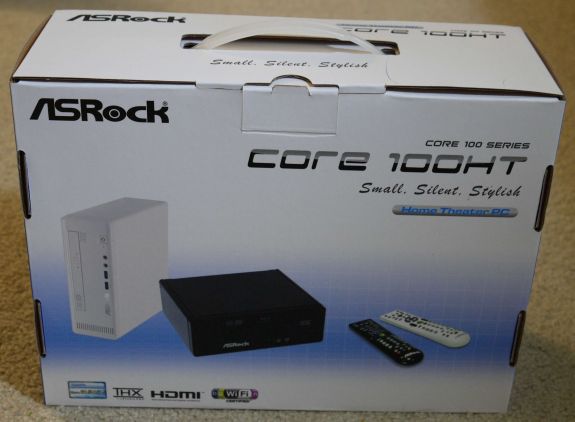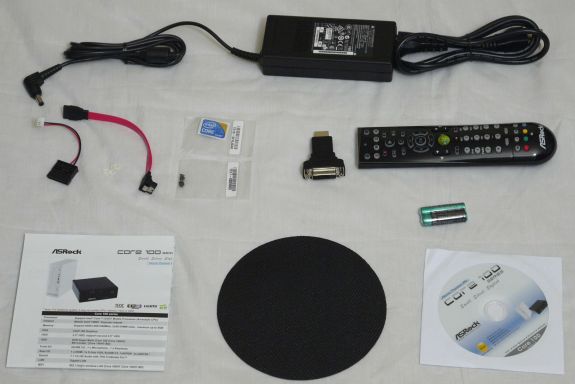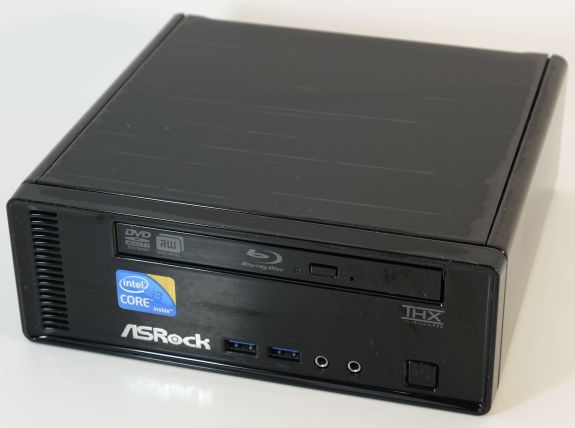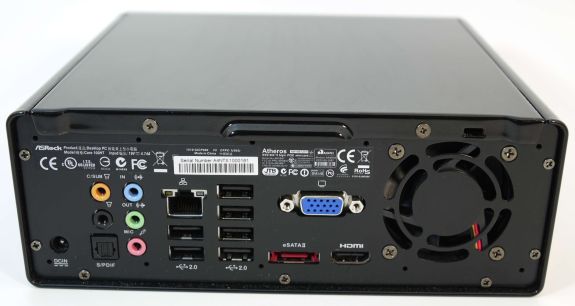ASRock Core 100HT-BD : Bringing HTPCs to the Mainstream Market [UPDATED : Noise Issue]
by Ganesh T S on July 19, 2010 9:34 PM EST- Posted in
- Home Theater
- Arrandale
- ASRock
- Media Streamer
- Core i3
- HTPC
The Core 100 HT-BD comes in a small package, and at first you wonder how such a powerful unit could come in such a small size.
Apart from the main unit, the package also bundles the following:
1. 90W AC / DC Adapter
2. SATA and power cables, as well as mounting screws for an optional second 2.5" hard disk
3. HDMI to DVI adapter
4. MCE remote and batteries.
5. Manual with instructions for disassembling and mounting the optional disk drive
6. Anti-slip pad for the base of the unit
7. CD with drivers and ASRock utilities
The appearance and dimensions of the unit are very similar to that of the ION 330-HT that was reviewed last August. The build quality of the chassis is top notch, and the unit will have no problem in blending with the A/V equipment of most consumers. However, the abrupt edges of the unit will not sit well with those interested more in the aesthetics and appearance rather than the internal capabilities of the unit. In the next iteration of the product, ASRock will probably work on the industrial design a bit more. Replacing the slimline Blu-Ray drive with a slot-loading type drive would also improve the appearance. These types of changes would enable them to cater to the segment of consumers who go more by the looks also.
We had mentioned in the ION 330 review about the absence of ports on the front panel being a bit strange, and ASRock has duly taken note, putting two USB 3.0 ports on the front panel. In addition, we also have headphone and microphone jacks in front. A set of vents on the left of the front panel helps in cooling the unit by maintaining air circulation. The slimline Blu-Ray drive is the same as those which make an appearance in various notebooks. The cost of such drives has come down drastically in the last 1 year, and we don't expect this component to add on too much cost over the DVD drive only version. Notably absent in the ION 330, but making an appearance in this unit is the THX logo above the power button to the right of the front panel.
ASRock uses the two sides of the unit as antennae for the Atheros WiFi module. Moving on to the rear of the unit, we find the adapter power input, followed by the audio ports. Analog audio output can be connected directly to the speakers, or the optical SPDIF output can be used to connect to older A/V receivers. Following this is the Gigabit Ethernet port, and 6 USB 2.0 slots. Further to the right, we have the VGA output (we really needed a DVI here), beneath which one gets the eSATA slot and HDMI output port. Wrapping up this panel is the ventilation fan. Our only gripe with the back panel is the placement of the eSATA port, which makes it difficult to connect external hard disks, particularly when the VGA port is being used.
Just like a notebook, this unit also supports simultaneous display on two monitors. Testing was done mostly with the HDMI output connected to a Toshiba REGZA 37" 1080p TV through an Onkyo TX-SR 606, and the VGA port connected to a old Dell monitor running at 1280x1024. It must be noted that the HDMI port on the unit is only 1.3a. This makes it impossible for the unit to drive monitors with resolutions higher than 1920x1080. Even extremely affordable 2048x1152 monitors such as this one from Dell are left unsupported at their maximum resolutions. However, we expect that this will not be a concern to buyers, since the unit will probably end up getting connected to a 1080p TV in most scenarios.
The Core 100 HT-BD ships with no OS installed. For the purpose of this review, we loaded up a copy of Windows 7 Ultimate x64. It is also possible to install Ubuntu or any other Linux distribution and still be able to take advantage of most of the HTPC functions of the system. Our analysis in the rest of the article, however, is completely from the Windows 7 standpoint.
Starting with this piece, all our media streamer and HTPC reviews will carry a table summarizing the data and A/V connectivity options for the unit from a home theater perspective. We will conclude this section with the same.
| Option | Status |
|---|---|
| HDMI | Yes [v1.3a] |
| Component | No |
| Composite | No |
| VGA | Yes |
| SPDIF | Yes [Optical] |
| Stereo | Yes |
| Option | Status |
|---|---|
| Optical Disk Drive | Yes [Blu-Ray] |
| USB | Yes [6 x v2.0, 2 x v3.0] |
| eSATA | Yes |
| LAN | Yes [ 1000 Mbps GbE ] |
| Internal HDD | Yes [ 500 GB ] |
| WiFi | Yes [ 300 Mbps 802.11n ] |
| Card Reader | No |














107 Comments
View All Comments
Lostclusters - Sunday, July 25, 2010 - link
I know the review mentioned things like "Perfect Blu-Ray playback with bitstreaming", and "able to play back all Blu-Rays with bitstreaming to the AV receiver", but there is no mention of whether the sound is at 24 bits or 16 bits. I am sure that the same limiting factors as any other PC comes into play. But as I am currently not very well informed on Windows 7, I'd like to see some mention of this in the review. Both with LPCM and native codec.ganeshts - Monday, July 26, 2010 - link
Lostclusters,The bitstreaming is perfect. This means whatever bit resolution is present in the soundtrack is passed on as-is, with no downsampling of any sort.
Its HDMI can pass through Dolby True HD and DTS HD Master Audio up to 192KHz/24-bit , whereas absence of passthrough would mean support for only Dolby or DTS 48KHz/16-bit audio quality.
Even on the other sound channel, i.e, VIA VT2020 codec, there exists support for Blu-ray audio up to 7.1ch 192KHz/24-bit audio with content protection.
Lostclusters - Sunday, July 25, 2010 - link
I forgot to mention that this should be examined not only when playing off a Bluray disk but when playing files off the hard drive as well.Lostclusters - Monday, July 26, 2010 - link
Another item not addressed (maybe in the bench marks) is was how it performed an SD media. I know the screen resolution is locked in at 1080. But how well does it play SD media?ganeshts - Monday, July 26, 2010 - link
Lostclusters,While I agree that the majority of the streams in the test suite were HD (after all, that is the future), we do have 5 - 6 SD streams (evident from the file names).
What you may be looking for is the upscaling capabilities of the GPU / software. I didn't pay much attention to this, but things didn't look horribly wrong. So, I would say that it is good enough to play SD media also. I am unable to think of a metric which will give you a quantitative view of the capability.
Lostclusters - Monday, July 26, 2010 - link
Check out this link at the bottom of the post under the heading of "My Pick of HTPC":http://www.avsforum.com/avs-vb/showthread.php?p=18...
LNCPapa - Monday, July 26, 2010 - link
This device really appeals to me - I was seriously considering going with a Mac Mini + Plex but with the price changes I figured I might as well not give Apple any more my money. By the way - great link post LostCluster - That thread was an awesome read and that guy has done an incredible amount of research.If this device had/would launch at a $500 price point I would purchase it now and ask the wife for forgiveness later.
ganeshts - Monday, July 26, 2010 - link
NewEgg seems to have the non-BluRay model for $580 + shipping:http://www.newegg.com/Product/Product.aspx?Item=N8...
Lostclusters - Monday, July 26, 2010 - link
I have been following Rene's work since his first recommendation on hardware. I have even donated to his work. He is one dedicated individual and has several threads on that forum. Many many good threads there. Chocked full of info.Decaff - Tuesday, July 27, 2010 - link
I really enjoyed reading through this article, as I am myself looking for a media streamer solution. I do, however, have some points of inquiry.First of all, the picture quality testing should be figured out. I have seen television review sites who do regular testing of the picture quality. I know that much of this is a often subjective, but I still think it is paramount that this is analysed, as many home theater enthusiasts are highly sensitive to the picture quality. I do think the use of the HQV test is a good starting point, but I still think subjective measures are in order, as a means of relating the numbers to any percieved loss of quality.
In essense, the people investing in HTPC's of media streamers will probably also have a quality TV-set/projector attached to it. So the framerate issue could naturally be a killer for many enthusiasts, as I know this particular issue has been discussed on many TV forums, where they are very concerned with configuring the TV properly to the correct framerate in order to achieve the right picture quality.
Perhaps an alliance with a site that specialises in reviewing picture quality of TV sets?
Secondly, I think you should be more aware of what software you are using on the machine. Naturally, Anandtech is largely a hardware site, but when dealing with a media streamer/HTPC it is essentially the software that defines the final user experience of the setup. Essentially, if I have just bought a HTPC, I don't want to be pestered with 3 different programs in order for the box to do its job. Rather I (and presumably almost everyone else) wants a nice interface that can handle all the tasks the box it built for, preferably using only the remote control, and the occasional keyboard/mouse when performing tasks that are PC-centric.
So my suggestion is to make a large article with HTPC software, where you look at the features it offers, ease of use, and naturally and in relation to my first point, the output quality of them.
Lastly, I'm really looking forward to seeing some reviews of more dedicated (smaller and cheaped) streamer boxes, such as the WDTV live, A.C. Ryan Playon!HD or the Popcorn machines and naturally also a comparison with the gaming consoles as the Playstation 3 or the Xbox 360 and how they fare in comparison, regarding codec support, and of course in the area of picture quality and ease of use.
These last are at the moment those that interest me the most, as I just want a box that can play my movies from an external HDD or a NAS/Home Server, without all the extra stuff (although it is of course nice to have), and I suspect a great deal of people have similar demands and can use another PC to rip their movies.